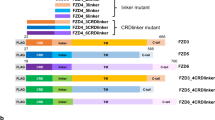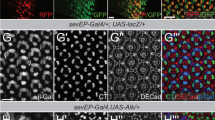Abstract
Wnt-signal transduction is critical for development and tissue homeostasis in a wide range of animal species and is frequently deregulated in human cancers. Members of the Frat/GBP family of glycogen synthase kinase 3β (Gsk3b)-binding oncoproteins are recognized as potent activators of the Wnt/β-catenin pathway in vertebrates. Here, we reveal a novel, Gsk3b-independent function of Frat converging on the activation of JNK and AP-1. Both these have been used as readouts for the noncanonical Frizzled/PCP pathway, which controls polarized cell movements and the establishment of tissue polarity. We find that Frat synergizes with Diversin, the mammalian homolog of the Drosophila PCP protein diego, in the activation of JNK/AP-1 signaling. Importantly, Frat mutants deficient for binding to Gsk3b retain oncogenic activity in vivo, suggesting that Wnt/β-catenin-independent events contribute to Frat-induced malignant transformation. The observed activities of Frat are reminiscent of the dual function of Dishevelled in the Wnt/β-catenin and Frizzled/PCP pathways and suggest that Frat may also function to bridge canonical and noncanonical Wnt pathways.
This is a preview of subscription content, access via your institution
Access options
Subscribe to this journal
Receive 50 print issues and online access
$259.00 per year
only $5.18 per issue
Buy this article
- Purchase on Springer Link
- Instant access to full article PDF
Prices may be subject to local taxes which are calculated during checkout







Similar content being viewed by others
References
Bax B, Carter PS, Lewis C, Guy AR, Bridges A, Tanner R et al. (2001). The structure of phosphorylated GSK-3beta complexed with a peptide, FRATtide, that inhibits beta-catenin phosphorylation. Structure (Camb) 9: 1143–1152.
Bilic J, Huang YL, Davidson G, Zimmermann T, Cruciat CM, Bienz M et al. (2007). Wnt induces LRP6 signalosomes and promotes dishevelled-dependent LRP6 phosphorylation. Science 316: 1619–1622.
Boutros M, Paricio N, Strutt DI, Mlodzik M . (1998). Dishevelled activates JNK and discriminates between JNK pathways in planar polarity and wingless signaling. Cell 94: 109–118.
Carpenter AE, Jones TR, Lamprecht MR, Clarke C, Kang IH, Friman O et al. (2006). CellProfiler: image analysis software for identifying and quantifying cell phenotypes. Genome Biol 7: R100.
Cong F, Schweizer L, Varmus H . (2004). Casein kinase Iepsilon modulates the signaling specificities of dishevelled. Mol Cell Biol 24: 2000–2011.
Etheridge SL, Ray S, Li S, Hamblet NS, Lijam N, Tsang M et al. (2008). Murine dishevelled 3 functions in redundant pathways with dishevelled 1 and 2 in normal cardiac outflow tract, cochlea, and neural tube development. PLoS Genet 4: e1000259.
Fanto M, McNeill H . (2004). Planar polarity from flies to vertebrates. J Cell Sci 117: 527–533.
Ferkey DM, Kimelman D . (2002). Glycogen synthase kinase-3 beta mutagenesis identifies a common binding domain for GBP and Axin. J Biol Chem 277: 16147–16152.
Fraser E, Young N, Dajani R, Franca-Koh J, Ryves J, Williams RS et al. (2002). Identification of the Axin and Frat binding region of glycogen synthase kinase-3. J Biol Chem 277: 2176–2185.
Habas R, Dawid IB, He X . (2003). Coactivation of Rac and Rho by Wnt/Frizzled signaling is required for vertebrate gastrulation. Genes Dev 17: 295–309.
Hamblet NS, Lijam N, Ruiz-Lozano P, Wang J, Yang Y, Luo Z et al. (2002). Dishevelled 2 is essential for cardiac outflow tract development, somite segmentation and neural tube closure. Development 129: 5827–5838.
Hino S, Michiue T, Asashima M, Kikuchi A . (2003). Casein kinase I epsilon enhances the binding of Dvl-1 to Frat-1 and is essential for Wnt-3a-induced accumulation of beta-catenin. J Biol Chem 278: 14066–14073.
Hocevar BA, Mou F, Rennolds JL, Morris SM, Cooper JA, Howe PH . (2003). Regulation of the Wnt signaling pathway by disabled-2 (Dab2). EMBO J 22: 3084–3094.
Hongisto V, Smeds N, Brecht S, Herdegen T, Courtney MJ, Coffey ET . (2003). Lithium blocks the c-Jun stress response and protects neurons via its action on glycogen synthase kinase 3. Mol Cell Biol 23: 6027–6036.
Jones C, Chen P . (2007). Planar cell polarity signaling in vertebrates. Bioessays 29: 120–132.
Jonkers J, Korswagen HC, Acton D, Breuer M, Berns A . (1997). Activation of a novel proto-oncogene, Frat1, contributes to progression of mouse T-cell lymphomas. EMBO J 16: 441–450.
Jonkers J, van Amerongen R, van der Valk M, Robanus-Maandag E, Molenaar M, Destree O et al. (1999a). in vivo analysis of Frat1 deficiency suggests compensatory activity of Frat3. Mech Dev 88: 183–194.
Jonkers J, Weening JJ, van der Valk M, Bobeldijk R, Berns A . (1999b). Overexpression of Frat1 in transgenic mice leads to glomerulosclerosis and nephrotic syndrome, and provides direct evidence for the involvement of Frat1 in lymphoma progression. Oncogene 18: 5982–5990.
Klein TJ, Jenny A, Djiane A, Mlodzik M . (2006). CKIepsilon/discs overgrown promotes both Wnt-Fz/beta-catenin and Fz/PCP signaling in Drosophila. Curr Biol 16: 1337–1343.
Klein TJ, Mlodzik M . (2005). Planar cell polarization: an emerging model points in the right direction. Annu Rev Cell Dev Biol 21: 155–176.
Lamprecht MR, Sabatini DM, Carpenter AE . (2007). CellProfiler: free, versatile software for automated biological image analysis. Biotechniques 42: 71–75.
Li L, Yuan H, Weaver CD, Mao J, Farr III GH, Sussman DJ et al. (1999a). Axin and Frat1 interact with dvl and GSK, bridging Dvl to GSK in Wnt- mediated regulation of LEF-1. EMBO J 18: 4233–4240.
Li L, Yuan H, Xie W, Mao J, Caruso AM, McMahon A et al. (1999b). Dishevelled proteins lead to two signaling pathways. Regulation of LEF-1 and c-Jun N-terminal kinase in mammalian cells. J Biol Chem 274: 129–134.
Maretto S, Cordenonsi M, Dupont S, Braghetta P, Broccoli V, Hassan AB et al. (2003). Mapping Wnt/beta-catenin signaling during mouse development and in colorectal tumors. Proc Natl Acad Sci USA 100: 3299–3304.
Mikkers H, Allen J, Knipscheer P, Romeijn L, Hart A, Vink E et al. (2002). High-throughput retroviral tagging to identify components of specific signaling pathways in cancer. Nat Genet 32: 153–159.
Moeller H, Jenny A, Schaeffer HJ, Schwarz-Romond T, Mlodzik M, Hammerschmidt M et al. (2006). Diversin regulates heart formation and gastrulation movements in development. Proc Natl Acad Sci USA 103: 15900–15905.
Qian D, Jones C, Rzadzinska A, Mark S, Zhang X, Steel KP et al. (2007). Wnt5a functions in planar cell polarity regulation in mice. Dev Biol 306: 121–133.
Saitoh T, Katoh M . (2001). FRAT1 and FRAT2, clustered in human chromosome 10q24.1 region, are up- regulated in gastric cancer. Int J Oncol 19: 311–315.
Sakanaka C, Sun TQ, Williams LT . (2000). New steps in the Wnt/beta-catenin signal transduction pathway. Recent Prog Horm Res 55: 225–236.
Schwarz-Romond T, Asbrand C, Bakkers J, Kuhl M, Schaeffer HJ, Huelsken J et al. (2002). The ankyrin repeat protein Diversin recruits Casein kinase Iepsilon to the beta-catenin degradation complex and acts in both canonical Wnt and Wnt/JNK signaling. Genes Dev 16: 2073–2084.
Simons M, Gloy J, Ganner A, Bullerkotte A, Bashkurov M, Kronig C et al. (2005). Inversin, the gene product mutated in nephronophthisis type II, functions as a molecular switch between Wnt signaling pathways. Nat Genet 37: 537–543.
Strutt H, Price MA, Strutt D . (2006). Planar polarity is positively regulated by casein kinase Iepsilon in Drosophila. Curr Biol 16: 1329–1336.
Theisen H, Purcell J, Bennett M, Kansagara D, Syed A, Marsh JL . (1994). Dishevelled is required during wingless signaling to establish both cell polarity and cell identity. Development 120: 347–360.
Thomas GM, Frame S, Goedert M, Nathke I, Polakis P, Cohen P . (1999). A GSK3-binding peptide from FRAT1 selectively inhibits the GSK3-catalysed phosphorylation of axin and beta-catenin. FEBS Lett 458: 247–251.
van Amerongen R, Berns A . (2005). Re-evaluating the role of Frat in Wnt-signal transduction. Cell Cycle 4: 1065–1072.
van Amerongen R, Nawijn M, Franca-Koh J, Zevenhoven J, van der Gulden H, Jonkers J et al. (2005). Frat is dispensable for canonical Wnt signaling in mammals. Genes Dev 19: 425–430.
van Amerongen R, van der Gulden H, Bleeker F, Jonkers J, Berns A . (2004). Characterization and functional analysis of the murine Frat2 gene. J Biol Chem 279: 26967–26974.
van der Lugt NM, Domen J, Verhoeven E, Linders K, van der Gulden H, Allen J et al. (1995). Proviral tagging in E mu-myc transgenic mice lacking the Pim-1 proto-oncogene leads to compensatory activation of Pim-2. EMBO J 14: 2536–2544.
Wallingford JB, Rowning BA, Vogeli KM, Rothbacher U, Fraser SE, Harland RM . (2000). Dishevelled controls cell polarity during Xenopus gastrulation. Nature 405: 81–85.
Wang J, Hamblet NS, Mark S, Dickinson ME, Brinkman BC, Segil N et al. (2006a). Dishevelled genes mediate a conserved mammalian PCP pathway to regulate convergent extension during neurulation. Development 133: 1767–1778.
Wang Y, Guo N, Nathans J . (2006b). The role of Frizzled3 and Frizzled6 in neural tube closure and in the planar polarity of inner-ear sensory hair cells. J Neurosci 26: 2147–2156.
Wang Y, Hewitt SM, Liu S, Zhou X, Zhu H, Zhou C et al. (2006c). Tissue microarray analysis of human FRAT1 expression and its correlation with the subcellular localisation of beta-catenin in ovarian tumours. Br J Cancer 94: 686–691.
Wang Y, Liu S, Zhu H, Zhang W, Zhang G, Zhou X et al. (2008). FRAT1 overexpression leads to aberrant activation of beta-catenin/TCF pathway in esophageal squamous cell carcinoma. Int J Cancer 123: 561–568.
Wang Y, Nathans J . (2007). Tissue/planar cell polarity in vertebrates: new insights and new questions. Development 134: 647–658.
Yan D, Wallingford JB, Sun TQ, Nelson AM, Sakanaka C, Reinhard C et al. (2001). Cell autonomous regulation of multiple Dishevelled-dependent pathways by mammalian Nkd. Proc Natl Acad Sci USA 98: 3802–3807.
Yost C, Farr III GH, Pierce SB, Ferkey DM, Chen MM, Kimelman D . (1998). GBP, an inhibitor of GSK-3, is implicated in Xenopus development and oncogenesis. Cell 93: 1031–1041.
Zeng X, Huang H, Tamai K, Zhang X, Harada Y, Yokota C et al. (2008). Initiation of Wnt signaling: control of Wnt coreceptor Lrp6 phosphorylation/activation via frizzled, dishevelled and axin functions. Development 135: 367–375.
Acknowledgements
We thank Dr Walter Birchmeier, Dr Hans Clevers, Dr Gerald Crabtree, Dr Trevor Dale, Dr Jolita Hendriksen, Dr Rob Michalides, and Dr Rob Wolthuis for providing constructs and reagents and Dr Ping Chen for advice on cochlear dissections. We thank Fina van de Ahé, Sjaak Greven, Loes Rijswijk, and Maaike Voetel for tail vein injections, Hanneke van de Gulden for generating the Frat1IAQA mutant, and Dr Joaquim Calbo-Angrill for reading of an early version of the manuscript. This work received financial support from the Centre of Biomedical Genetics (CBG).
Author information
Authors and Affiliations
Corresponding author
Additional information
Supplementary Information accompanies the paper on the Oncogene website (http://www.nature.com/onc)
Rights and permissions
About this article
Cite this article
van Amerongen, R., Nawijn, M., Lambooij, JP. et al. Frat oncoproteins act at the crossroad of canonical and noncanonical Wnt-signaling pathways. Oncogene 29, 93–104 (2010). https://doi.org/10.1038/onc.2009.310
Received:
Revised:
Accepted:
Published:
Issue Date:
DOI: https://doi.org/10.1038/onc.2009.310
Keywords
This article is cited by
-
Aseptic loosening around total joint replacement in humans is regulated by miR-1246 and miR-6089 via the Wnt signalling pathway
Journal of Orthopaedic Surgery and Research (2024)
-
The miR-3648/FRAT1-FRAT2/c-Myc negative feedback loop modulates the metastasis and invasion of gastric cancer cells
Oncogene (2022)
-
LRP16 prevents hepatocellular carcinoma progression through regulation of Wnt/β-catenin signaling
Journal of Molecular Medicine (2018)
-
Rare intronic variants of TCF7L2 arising by selective sweeps in an indigenous population from Mexico
BMC Genetics (2016)
-
Roles of Wnt Signaling in the Neurogenic Niche of the Adult Mouse Ventricular–Subventricular Zone
Neurochemical Research (2016)



